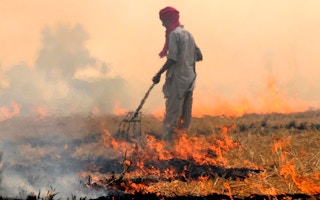The Indo-Gangetic Plains, a vast region spanning Pakistan, parts of Punjab and Haryana in India (Indus), and Uttar Pradesh, Bihar, and West Bengal in India, as well as Nepal and Bangladesh (Gangetic Plains), has garnered notoriety for being one of the most polluted areas in the world. The alarming pollution levels are primarily attributed to the high concentrations of aerosols, leading to frequent episodes of haze, fog, and smog, especially during the winter months from October to March each year. This environmental concern is exacerbated by the region’s humid subtropical climate, characterised by mild, dry, and relatively short winters often accompanied by thick fog. The dense smog and fog significantly impact the daily lives and livelihoods of millions of people across the region.
Major cities like Delhi and Amritsar in India, and Lahore, Faisalabad, and Gujranwala in Pakistan, grapple with severe air pollution, particularly during the winter season. A combination of factors, including crop residue burning, industrial emissions, vehicular pollution, and construction activities, contribute to the formation of hazardous smog, resulting in poor air quality. The cities consistently confront the escalating issue of smog, which reappears every winter with greater intensity, often ranking among the world’s cities with the worst air quality.
Throughout November, satellites frequently capture extensive smoke and heightened fire activity in northwestern India, mainly due to stubble burning. This agricultural practice involves farmers burning excess paddy straw after the harvest to quickly clear fields for the next planting season. While it provides convenience, stubble burning has several adverse consequences, including environmental and health concerns. The crop-burning season typically lasts for two to four weeks in November.
In response to the deteriorating air pollution, governments, environmental organisations, and communities are taking action to combat the problem, recognising the significant health and well-being risks faced by the region’s residents. The pursuit of effective solutions and the promotion of sustainable practices remain ongoing endeavors, with the aspiration of restoring clearer skies and healthier air to this critical region.
Both India and Pakistan acknowledge the essential nature of addressing the challenge of crop residue burning. They have implemented initiatives to promote mechanisation and technology in agriculture, offering financial incentives and subsidies to farmers for adopting modern machinery that efficiently manages crop residues without resorting to burning. For instance, India’s “Promotion of Agricultural Mechanisation for In-Situ Management of Crop Residue” scheme and the establishment of Custom Hiring Centers are notable steps in this direction.
In Pakistan, the introduction of financial assistance programs and subsidies for machinery aims to encourage farmers to adopt modern practices. Concurrently, research and development efforts are actively underway to develop more suitable technologies. In 2021, the Punjab Government in Pakistan declared smog a calamity and instructed the Punjab Disaster Management Authority (PDMA) to take action against crop burning and reduce emissions in the province. Subsequently, in 2022, the Lahore High Court directed the provincial government to close schools in Lahore for three days a week due to the worsening smog situation. Responding to the escalating air pollution, the Chief Minister of Punjab declared an emergency in the city and directed authorities to devise a comprehensive plan to combat the issue. To this end, a ban on crop residue burning was enforced across the province, with strict penalties for violations. Furthermore, modern harvesters were offered to farmers to discourage stubble burning.
Despite efforts, challenges persist in enforcing policies and ensuring widespread adoption of modern practices. The lack of awareness among farmers, limited access to machinery, and adherence to traditional practices pose hindrances to progress.
To address these challenges effectively, both countries must intensify their focus on strengthening awareness campaigns and farmer education programs. These endeavors are instrumental in promoting the benefits of residue management practices and discouraging crop burning. Moreover, efforts to improve access to modern machinery through initiatives like Custom Hiring Centers are crucial in encouraging wider adoption among farmers. Fostering partnerships with agricultural organisations and non-governmental organisations will further support dissemination efforts and facilitate the adoption of sustainable practices on a broader scale.
International support and funding also play a pivotal role in tackling this issue. Both India and Pakistan have actively engaged in international partnerships and sought support for environmental initiatives. Continuous participation in global climate summits and conferences enables them to advocate for climate-friendly practices and garner support for projects aimed at reducing air pollution from agricultural sources. Collaborations with esteemed international entities like the United Nations Environment Programme (UNEP) and the World Health Organisation (WHO) provide access to technical expertise and financial aid, bolstering efforts to combat crop residue burning. Leveraging public-private partnerships with international companies and research institutions can further mobilise resources and funding for projects addressing crop residue burning.
By prioritising these key strategies and seeking international backing, India and Pakistan can significantly reduce crop residue burning, improve air quality, and foster sustainable agricultural practices. Recognising that this issue transcends national boundaries, both countries must work together and adopt a collective regional approach to find effective and lasting solutions. By joining forces, they can successfully mitigate smoke and improve air quality in the Indo-Gangetic region, ultimately benefiting the environment and enhancing the well-being of their citizens.
It is important to continue monitoring developments and staying updated on the latest policy landscape and global environmental initiatives. Engaging in open dialogues and knowledge-sharing with other countries facing similar air pollution challenges will enable a collaborative approach to combat this pressing issue. With concerted efforts and a united approach, India and Pakistan can pave the way for a healthier and more sustainable future in the Indo-Gangetic Plains.
Professor Abdul Waheed Bhutto is a researcher and academician with over two decades of experience in the field of engineering. He has authored numerous research papers, which have been published in renowned international journals, and his work has been widely cited by peers in the field. Professor Bhutto is currently affiliated with Dawood University of Engineering and Technology, Karachi- Pakistan.









